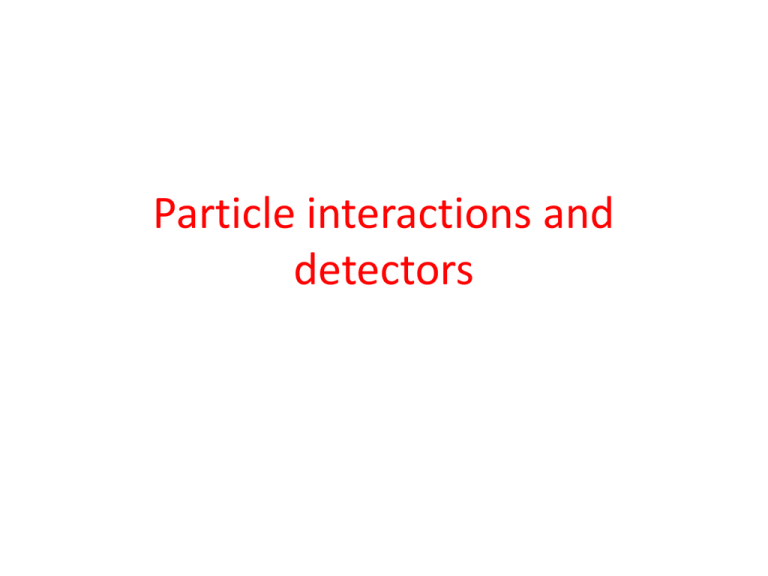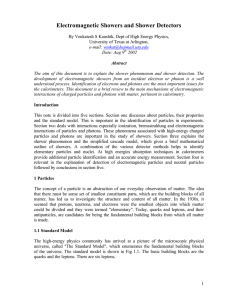Particle interactions and detectors
advertisement

Particle interactions and detectors Interactions of particles with matter • Particle detectors measure physical quantities related to the outcome of a collision; they should ideally identify all the outcoming (and the incoming, if unknown) particles, and measure their kinematical characteristics (momentum, energy, velocity). • In order to detect a particle, one must make use of its interaction with a sensitive material. The interaction should possibly not destroy the particle one wants to detect; however, for some particles this is the only way to obtain information about them. • In order to study the properties of detectors, we shall first need to review the characteristics of the interaction of particles with matter. Charged particle interactions • Charged particles interact basically with atoms, and the interaction is mostly electromagnetic: they might expel electrons (ionization), promote electrons to upper energy levels (excitation), or radiate photons (bremsstrahlung, Cherenkov radiation, transition radiation). High energy particles may also interact directly with the atomic nuclei. Ionization energy loss The Landau distribution High energy radiation effects Cherenkov radiation (ß>1/n) Transition radiation Multiple scattering Photon interactions Compton scattering Pair production Track detectors Cloud chamber & bubble chamber Nuclear emulsions Ionization counter, proportional counter, Geiger-Muller counter Wire chambers Drift chambers Semiconductor position detectors Scintillators RPC Photodetectors Photomultiplier tubes Silicon photomultipliers Multiplicative showers (Rossi 1934) • Cascades of particles produced as the result of a primary high-energy particle interacting with matter – The incoming particle interacts, producing multiple new particles with lesser energy; each of these interacts in turn, a process that continues until many particles are produced. These are then stopped in the matter and absorbed • 2 basic types of showers: – electromagnetic showers are produced by a particle that interacts via the electromagnetic force, a photon or electron – Hadronic showers are produced by hadrons, and proceed mostly via the strong nuclear force • Same principle, similar detectors, different characteristics (we’ll study electromagnetic 33 QED HE processes: bremsstrahlung for electrons… • (and pair production for photons). Forbidden in vacuo by 4-momentum conservation – Require interaction with the medium • Bremsstrahlung: photons of momentum q<Ee emitted with probability ~proportional to 1/q – (and collimated: ~ me/E) ie, energy emission is ~constant for each interval of photon energy; total is propto E – The dependence on the material appears through the radiation length Xo: dEe/dx = -1/Xo – Xo can be found in tables. It is ~400 m for air at NTP, ~43 cm for water; for density 1 g/cm3 roughly proportional to A/Z2 • Collision energy loss is almost constant (plateau) 34 QED HE processes: …pair production for photons • Pair production: l = (9/7) Xo for Eg >> 2me Energy spectrum ~ flat 35 Electromagnetic showers • When a high-energy e or g enters an absorber, it initiates an em cascade as pair production and bremsstrahlung generate more e and g with lower energy • The ionization loss becomes dominant < the critical energy Ec – Ec ~ 84 MeV in air, ~73 MeV in water; ~ (550/Z)MeV • Approximate scaling in y = E/Ec – The longitudinal development ~scales as the radiation length in the material: t = x/Xo – The transverse development scales approximately with the Moliere radius RM ~ (21 MeV/Ec) Xo • In average, only 10% of energy outside a cylinder w/ radius RM • In air, RM ~ 80 m; in water RM ~ 9 cm • Electrons/positrons lose energy by ionization during the cascade process • Not a simple sequence: needs Monte Carlo calculations 36 Asimplified approach • If the initial electron has energy E0>>EC , after t Xo the shower will contain 2t particles. ~equal numbers of e+, e-, g, each with an average energy E(t) = E0/2t • The multiplication process will cease when E(t)=EC 37 An analytic model: Rossi’s “approximation B” • Rossi in 1941 published an analytical formulation for the shower development as a set of 2 integrodifferential equations under the approximation that: – Electrons lose energy by ionization & bremsstrahlung; asymptotic formulae hold – Photons undergo pair production only; asymptotic formulae hold (E > 2 me) • Very good approximation until E ~ Ec 38 Energy measurement • The calorimetric approach: absorb the shower – As much as possible… But the logarithmic behavior helps – Typically (20-30) Xo give an almost full containment up to hundreds of GeV • But sometimes it is difficult (calorimeters in space) – Errors asymptotically dominated by statistical fluctuations: E kE c E E 39 Hadronic showers and calorimeters • Although hadronic showers are qualitatively similar to em, shower development is more complex because many different processes contribute – Larger fluctuations • Some of the contributions to the total absorption may not give rise to an observable signal in the detector – Examples: nuclear excitation and leakage of secondary muons and neutrinos • Depending on the proportion of π0s produced in the early stages of the cascade, the shower may develop predominantly as an electromagnetic one because of the decay π0→γ γ • The scale of the shower is determined by the nuclear absorption length lH – Since typically lH > Xo, hadron calorimeters are thicker than em ones • The energy resolution of calorimeters is in general much worse for hadrons than for electrons and photons – Energy resolution typically a factor of 5–10 poorer than in em calorimeters Go cheap: sandwich 40



